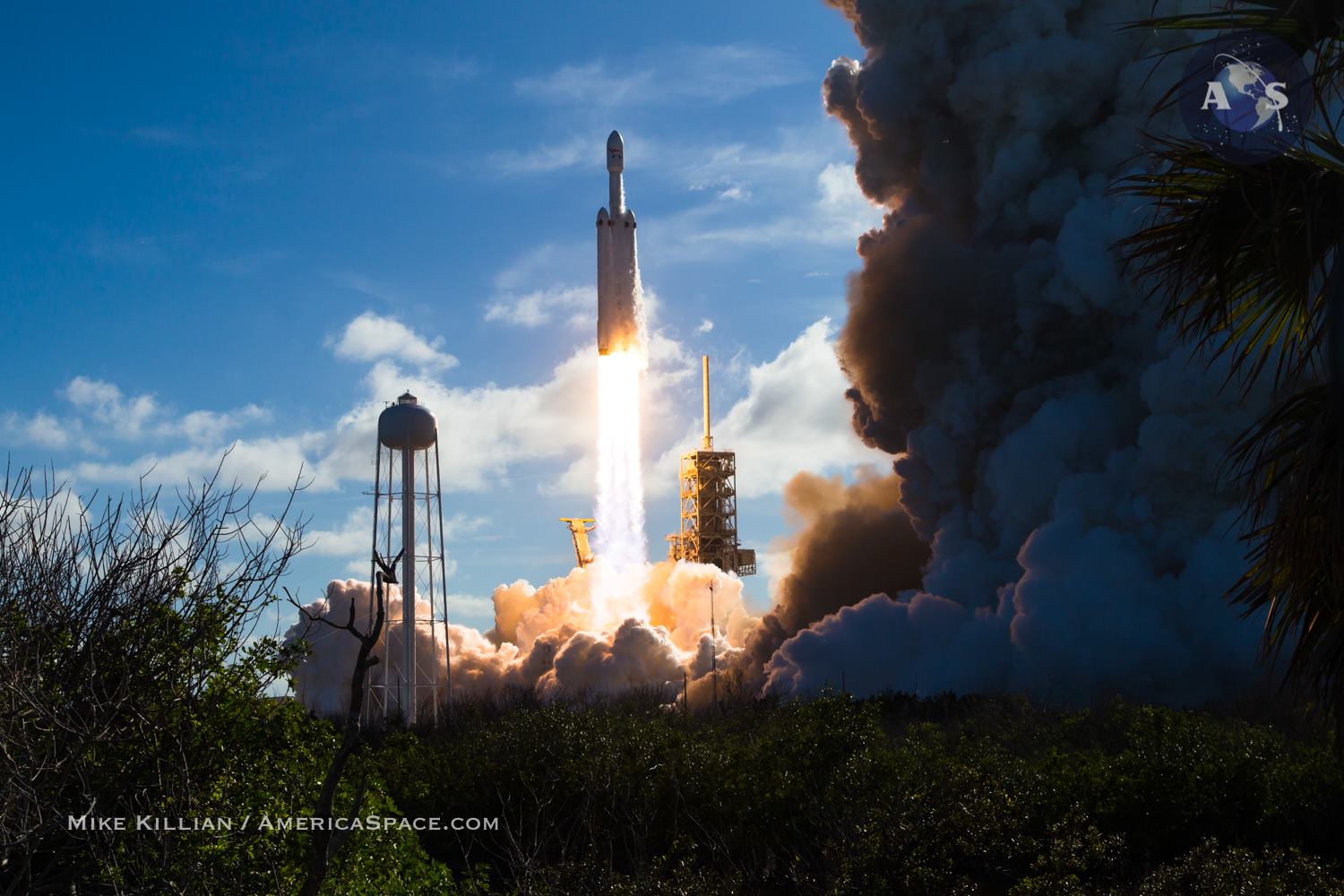
Riding the plumes of its 27 engines, and carrying the hopes and dreams of a generation, the most powerful rocket in the world took flight earlier today (Tuesday, 6 February), as SpaceX’s mammoth Falcon Heavy conducted its long-awaited maiden test-flight. The “triple niner”—which boasts three Upgraded Falcon 9 booster cores, each equipped with nine Merlin 1D+ engines—lifted off from historic Pad 39A at the Kennedy Space Center (KSC) in Florida at 3:45 p.m. EST, just 45 minutes before the closure of Tuesday’s three-hour “window”. Efforts to get the Heavy airborne earlier in the window had been frustrated by concerns over upper-level wind shear. Eight minutes after launch, the Heavy’s two side-mounted boosters smoothly alighted on separate pads at Landing Zones (LZ) 1 and 2 at nearby Cape Canaveral Air Force Station, but it can be confirmed that the center core stage did not succeed in touching down on the Autonomous Spaceport Drone Ship (ASDS), nicknamed “Of Course I Still Love You”, in the Atlantic Ocean.
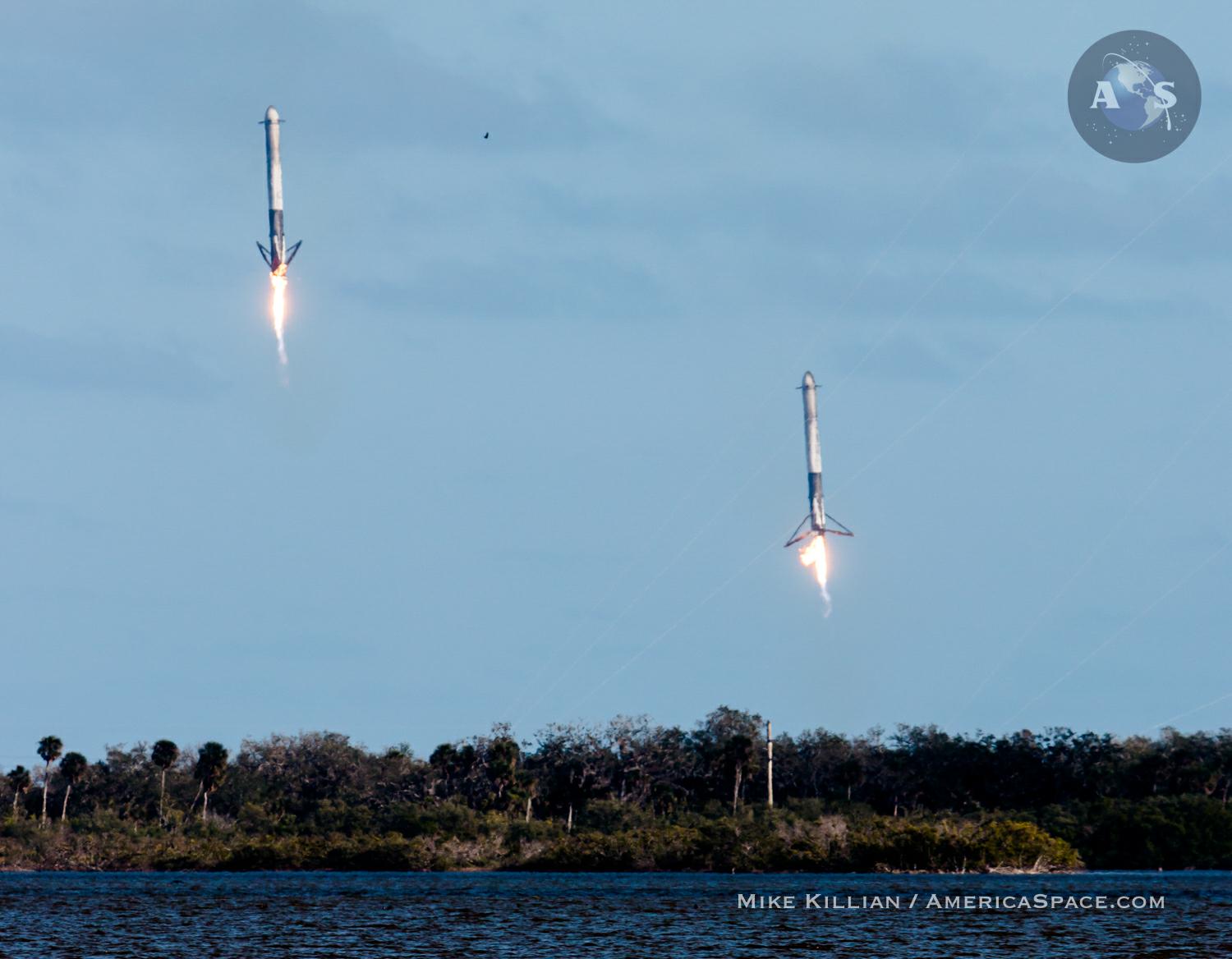
“All of us in this business know the effort it takes to get to a first flight of any new vehicle and recognize the tremendous accomplishment we witnessed today,” said Acting NASA Administrator Robert Lightfoot. “I am really proud of the hard work of our NASA team, in particular at Kennedy, for the transformation into a multi-user spaceport. Watching the Falcon Heavy rise above the historic pad that has been the launch point for so many critical missions is a true testament to the hard work transitioning our nation’s launch infrastructure in support of the commercial launch industry.”
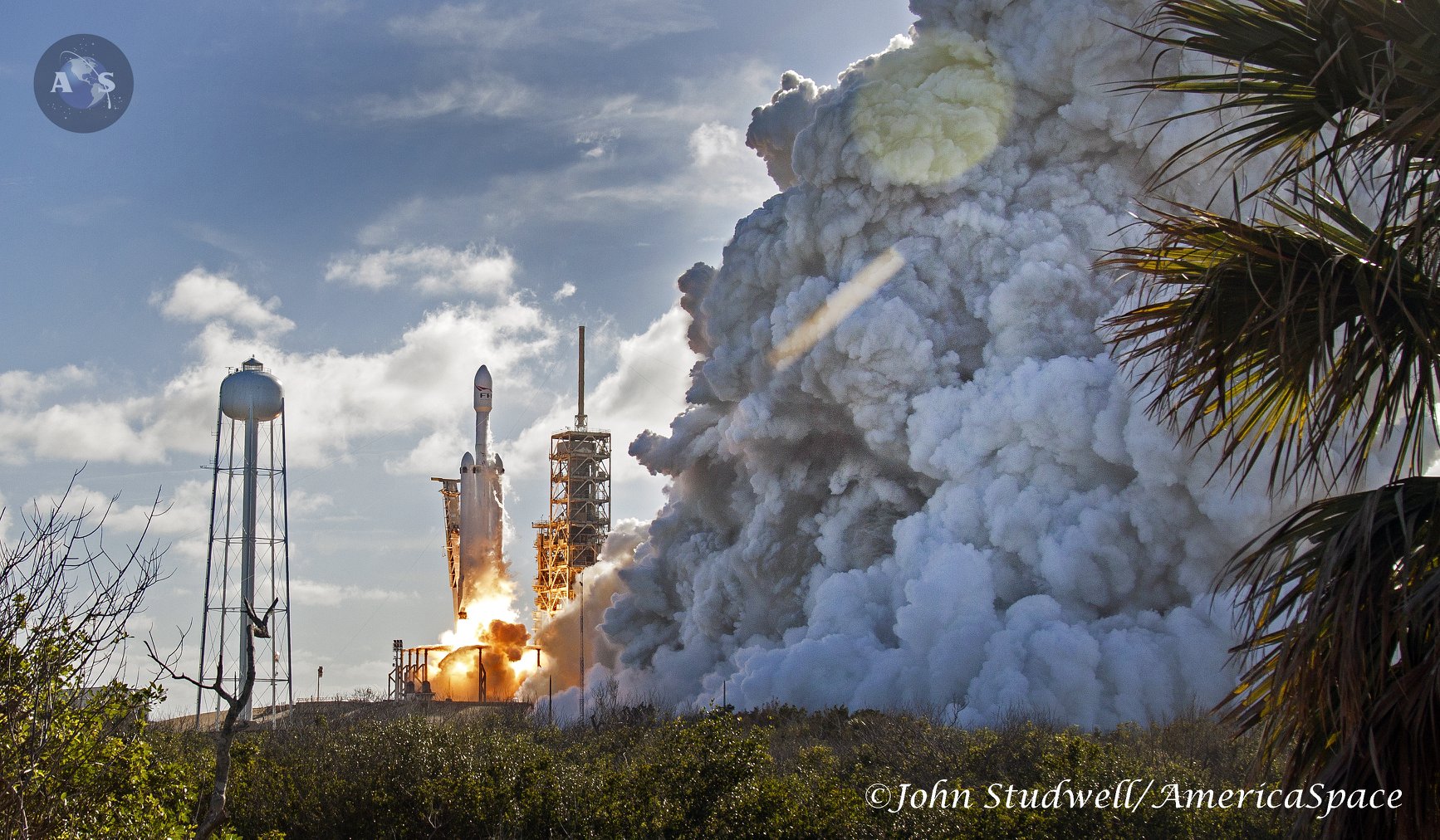
“The successful launch of a new vehicle on its first flight is a significant accomplishment they can be very proud of,” added KSC Director and former shuttle astronaut Bob Cabana. “As a multi-user spaceport, I look forward to the continued expansion of commercial spaceflight from Kennedy and the integration of a new class of launch vehicle into our Nation’s space program.”
Today’s phenomenal success comes only weeks after the 50th anniversary of the first voyage of the Saturn V and it is difficult not to feel a pang of nostalgia and an uplifting sense of optimism for future space exploration. As outlined previously by AmericaSpace, the Falcon Heavy was long expected to become the most powerful rocket in active operational service. Its 27 Merlin 1D+ first-stage engines would punch out 5.4 million pounds (2.4 million kg) of thrust at the instant of liftoff, more than double the 2.2 million pounds (1 million kg) produced by the United Launch Alliance (ULA) Delta IV Heavy, which is now relegated to second place on the list of highest-capacity rockets. With such an immense lifting capability, the Falcon Heavy can deliver 140,700 pounds (63,800 kg) to low-Earth orbit, 58,900 pounds (26,700 kg) to Geostationary Transfer Orbit (GTO) and 37,000 pounds (16,800 kg) to Mars. Admittedly, the Heavy does not reach the liftoff thrust achieved by the last few Saturn V vehicles, which peaked at close to 7.6 million pounds (3.4 million kg) and falls far short of the reported 10.2 million pounds (4.6 million kg) attained at launch by the Soviet Union’s ill-fated N-1 super-heavylifter.
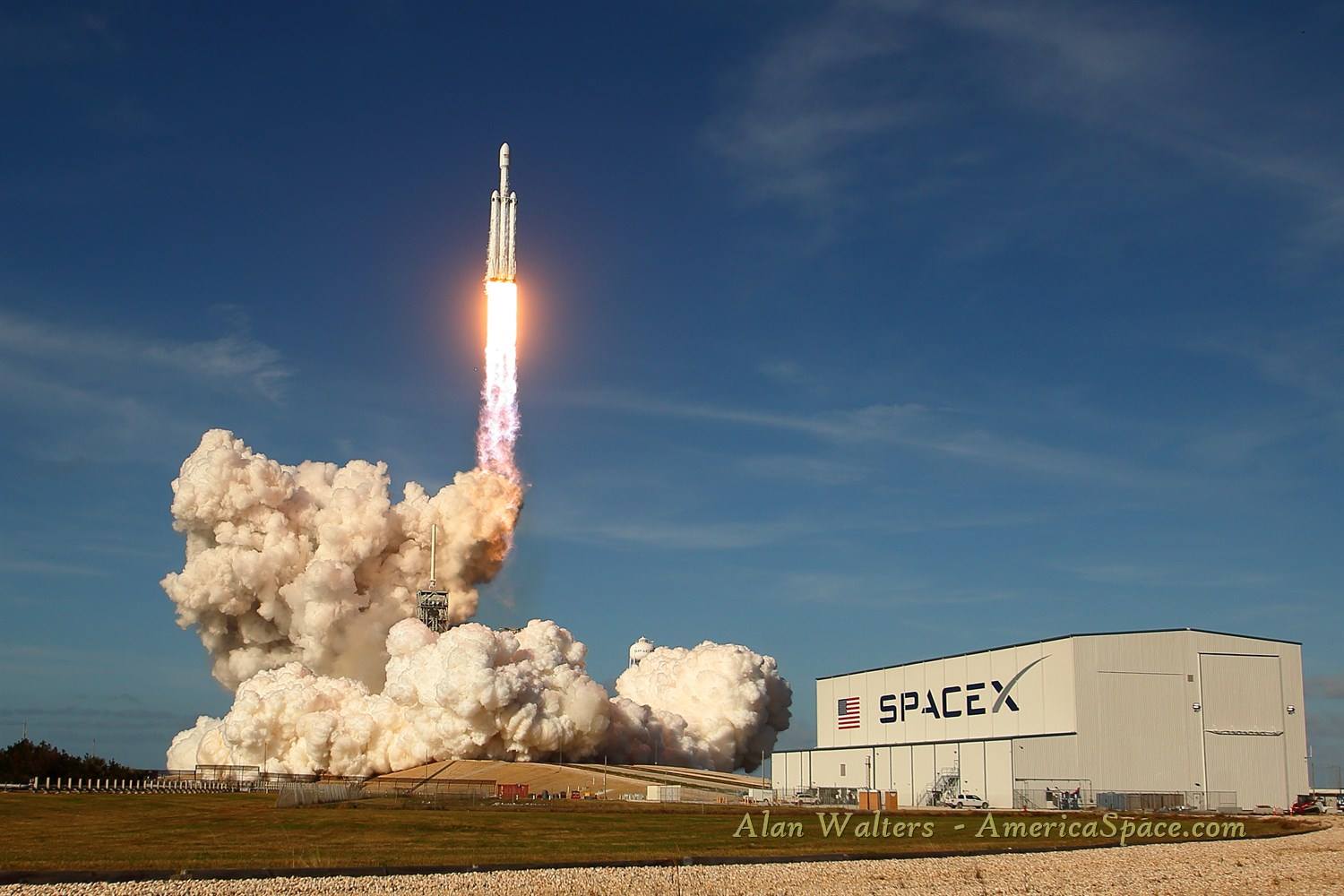
Yet with NASA’s evolvable Space Launch System (SLS) still up to two years away from its maiden voyage, the success of today’s mission puts the Falcon Heavy in pole position to draw some impressive contracts. Already lined up for the booster are Saudi Arabia’s 13,200-pound (6,000 kg) Arabsat 6A communications satellite, slated to fly later this year, as well as the Space Test Program (STP)-2 group of payloads for the Department of Defense, flying in support of the Air Force’s Evolved Expendable Launch Vehicle (EELV) certification process for the Heavy. Other missions were contracted with Intelsat—the Heavy’s first commercial client—and Inmarsat, although ongoing delays to the new booster prompted them to be shifted onto either the Upgraded Falcon 9 or onto Europe’s Ariane 5. Further ahead, the Heavy’s first crewed voyage is expected to see a pair of private tourists circumnavigate the Moon, as outlined by SpaceX CEO Elon Musk in February 2017.
Formally unveiled as a concept almost seven years ago, the Falcon Heavy’s development process has been a long and tortured one, with Mr. Musk acquiescing that the idea was far more complex than “simply” strapping three Falcon 9 cores together. Early plans envisaged the debut of the booster in 2013 or 2014, with the first flight conducted from Vandenberg Air Force Base, Calif., followed by missions from the East Coast. In spite of initial doubts about the new rocket’s capabilities, SpaceX secured a 20-year lease of Pad 39A in April 2014, with an expectation that the historic Apollo-era launch complex would provide the foundation for the Heavy’s inaugural voyages. Agonizingly, the booster fell further and further behind schedule, with the maiden launch always seemingly slated to occur “this year”, yet continually slipping to the right.
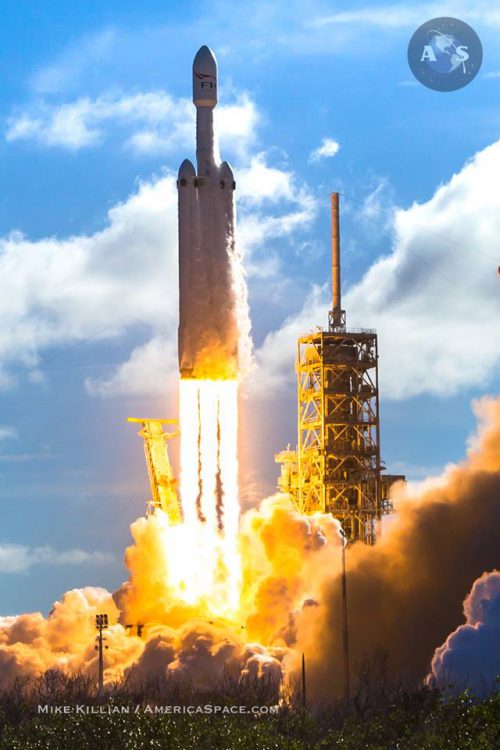
A glimmer of hope emerged late in 2017, when Mr. Musk revealed the first images of Falcon Heavy hardware being readied in the horizontal integration facility, close to Pad 39A. It was announced that the two side-mounted boosters would be “re-flown” cores which previously saw service to loft the Thaicom-8 communications satellite to geostationary orbit in May 2016 and the CRS-9 Dragon towards the International Space Station (ISS) the following July. By contrast, the central core of the first Falcon Heavy would be entirely new. It was expected that the side-mounted boosters would return to alight on solid ground on two separate pads at the Cape’s Landing Zones (LZ) 1 and 2, whilst the central core would attempt an oceanic touchdown on the ASDS in the Atlantic Ocean. Teasing his followers, Mr. Musk revealed in December that instead of flying an “extremely boring” mass simulator aboard the first Heavy, SpaceX would instead fly a midnight cherry-red Tesla Roadster car, targeted on a heliocentric trajectory, to cross Mars’ orbit and spend perhaps a billion years in space. More recently, it became clear that the “Starman”—a fully-suited mannequin “passenger”—would occupy the driver’s seat, serenaded by the strains of David Bowie.
Shortly before the New Year, the Heavy was erected on Pad 39A, showing off its 230-foot-tall (70-meter) bulk to the world for the first time. Measuring 40 feet (12.2 meters) across the diameter of its three boosters, it weighed a total of 3.1 million pounds (1.4 million kg), a suitable incumbent for a launch pad which had previously played host to the gargantuan Saturn V and, more recently, the Space Shuttle. Following several days of fit-checks, the booster was returned to the horizontal integration facility, before returning to the pad in mid-January and, after several false starts, conducted a successful Static Fire Test of its 27 engines on the 24th. “Falcon Heavy hold-down firing this morning was good,” tweeted Mr. Musk. “Generated quite a thunderhead of steam.” At length, SpaceX settled on Tuesday, 6 February for the opening launch attempt, with a three-hour window, extending from 1:30 p.m. through 4:30 p.m. EST. The ASDS reportedly departed Port of Jacksonville early on Saturday, 3 February, headed for its position in the Atlantic Ocean.
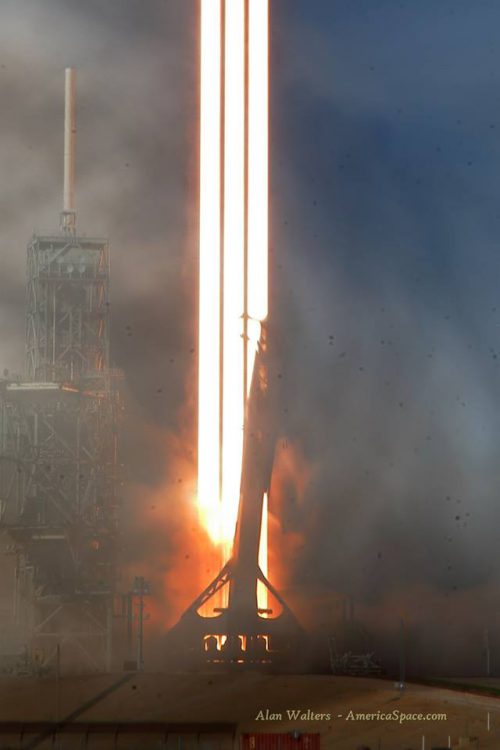
The weather outlook for Tuesday was expected to be favorable, with the 45th Weather Squadron at Patrick Air Force Base predicting an 80-percent probability of good conditions for the three-hour “window”, tempered by a risk of violating the Liftoff Winds and Thick Cloud Rules. It was expected that winds would become more easterly at about 15 mph (24 km/h), with a few low-level clouds coming in off the water, with maximum upper-level winds from the west at 90 knots near 40,000 feet (12,000 meters). As launch day dawned, conditions seemed to improve to 90-percent favorable, but the upper-level wind situation prompted a slight shift until 2:20 p.m., almost an hour into the window. “Continuing to minitor winds and will update as info becomes available,” SpaceX tweeted. Revised launch times of 2:50 p.m. and 3:10 p.m. were subsequently determined, with SpaceX eventually co-ordinating a T-0 at 3:45 p.m. Eighty-five minutes before launch, the loading of a highly refined form of rocket-grade kerosene (known as “RP-1”) into the core and side-mounted boosters got underway. By 3 p.m., the side-mounted boosters were fully fueled and entered “topping” and the loading of liquid oxygen got underway.
The minutes ticked onward and at T-60 seconds the vehicle entered “Startup”, in which the Falcon Heavy’s on-board computers assumed primary command of the vehicle’s critical functions. At 3:45 p.m., the Pad 39A surface was pummeled with 5.4 million pounds (2.4 million kg) of thrust and spectators along the Space Coast were greeted by a vast cloud of smoke, before the wall of sound hit them. Ponderously, the booster rose from the pad and began to climb into the crystal Florida sky. Notwithstanding Mr. Musk’s personal doubts that this mission might fail, or achieve limited success, each milestone seemed to smoothly and effortlessly tick itself off the list. At 2.5 minutes into the flight, the two side-mounted boosters were jettisoned, followed by the shutdown and separation of the first stage of the center core. All three boosters plummeted back Earthward, headed for their respective landing spots. Next, the Merlin 1D+ Vacuum engine of the second stage ignited, beginning a voyage more closely akin to previous Upgraded Falcon 9 launches. Even SpaceX’s John Insprucker noted that, from this point onward, the Heavy’s flight profile mirrored that of a “standard” mission.
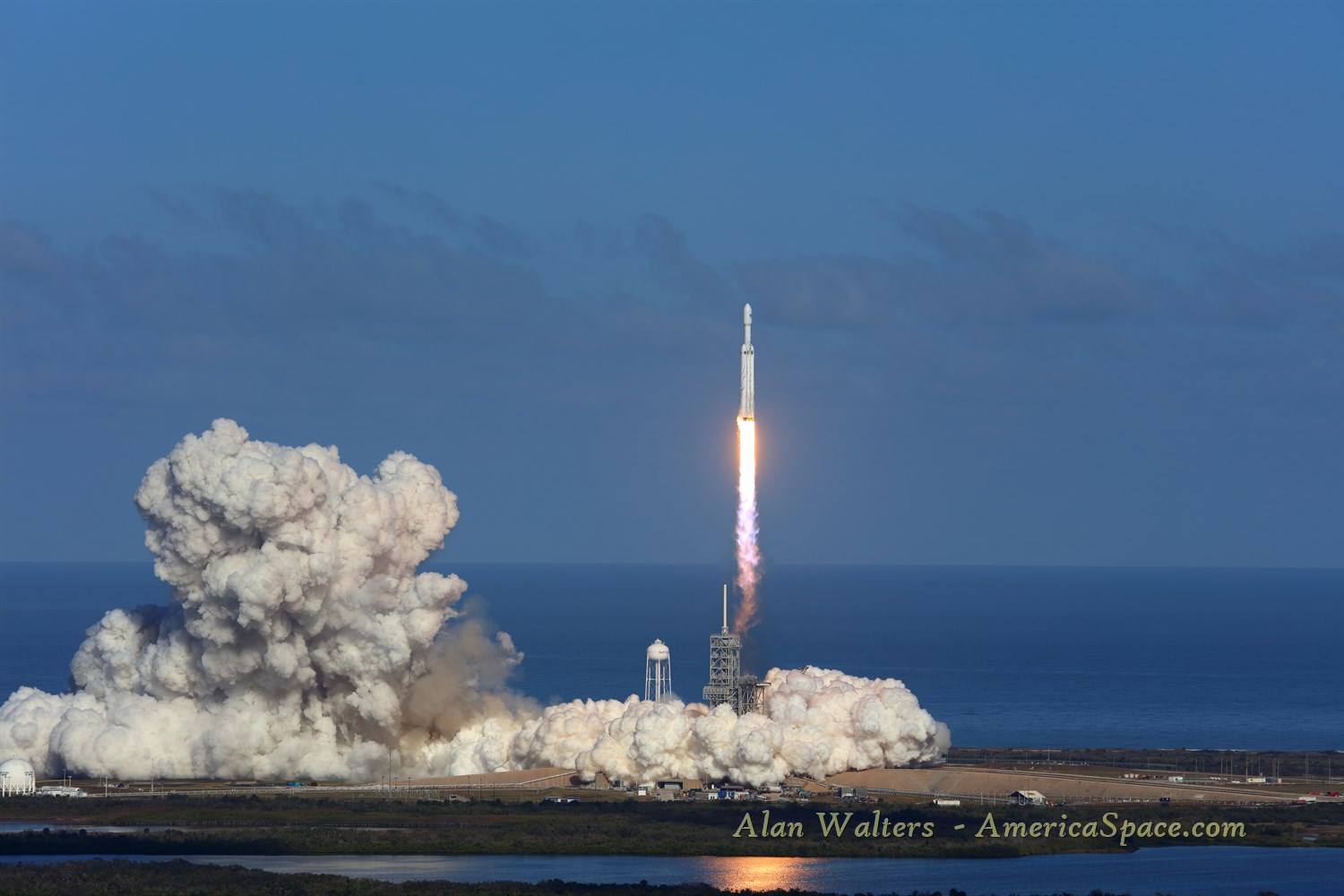
But today’s mission was far from standard. Eight minutes after leaving KSC, the two side-mounted boosters—like a pair of twirling ballet-dancers—plunged from the skies, virtually side-by-side, synchronized almost to the second, and alighted on separate ground pads. “Falcon Heavy side cores have landed at SpaceX’s Landing Zones 1 and 2,” the company noted at 3:54 p.m. In the meantime, on the tenuous edge of the atmosphere, the second stage shut down at 3:55 p.m. The stack coasted for several minutes, before the Merlin 1D+ Vacuum was re-lit at 4:14 p.m., to position Mr. Musk’s Tesla Roadster into a coasting orbit, ahead of injection onto a heliocentric trajectory. “Upper stage restart nominal, apogee raised to 4,350 miles (7,000 km),” tweeted Mr. Musk at 4:30 p.m. “Will spend five hours getting zapped in Van Allen [radiation] belts & then attempt final burn for Mars.”
And it was at this point that perhaps the next most astonishing images from the mission appeared: views of “Starman”, gloved hands on the wheel of the Roadster, backdropped by the glorious, cloud-flecked limb of Earth rising in the windshield. Millions of mesmerized YouTube watchers struggled to ascertain if the views were fake or Photoshopped. Later, at a post-launch press conference, Mr. Musk himself set them straight. Pointing to the lack of an atmosphere, which lent a weird clarity to the scene, he joked that “You can tell it’s real…because it looks so fake!”
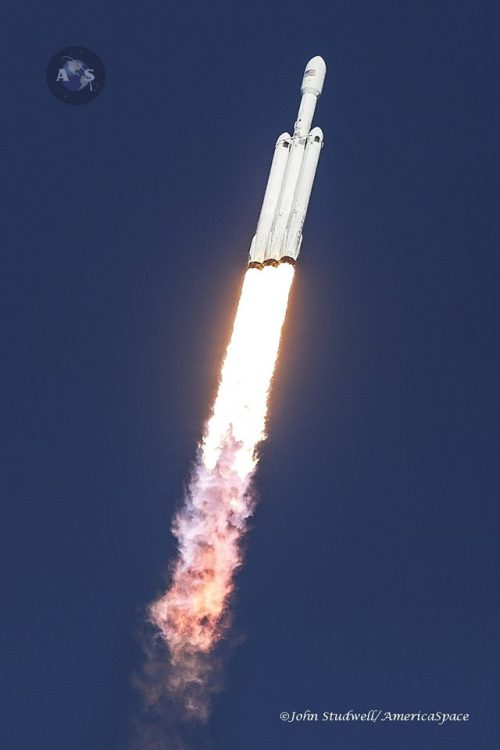
He went on to describe the newly-returned side-mounted boosters as being “in really good condition” and “both reflyable”. Moreover, seeing them land in tandem, gave Mr. Musk “a lot of faith in our next architecture”. By his own admission, he did not anticipate the mission to succeed as well as it did. “Crazy things can come true,” he told a rapt audience. “I didn’t really think this could work.” And part of the mission, it seems, did not go to plan. The center core of the booster apparently only lit one of the three engines for its Landing Burn and ended up hitting the ocean at 300 mph (480 km/h). Mr. Musk noted that there were no plans to re-use the center core and that he was satisfied with the successful recovery of the side-mounted boosters, which were fitted with upgraded titanium grid-fins.
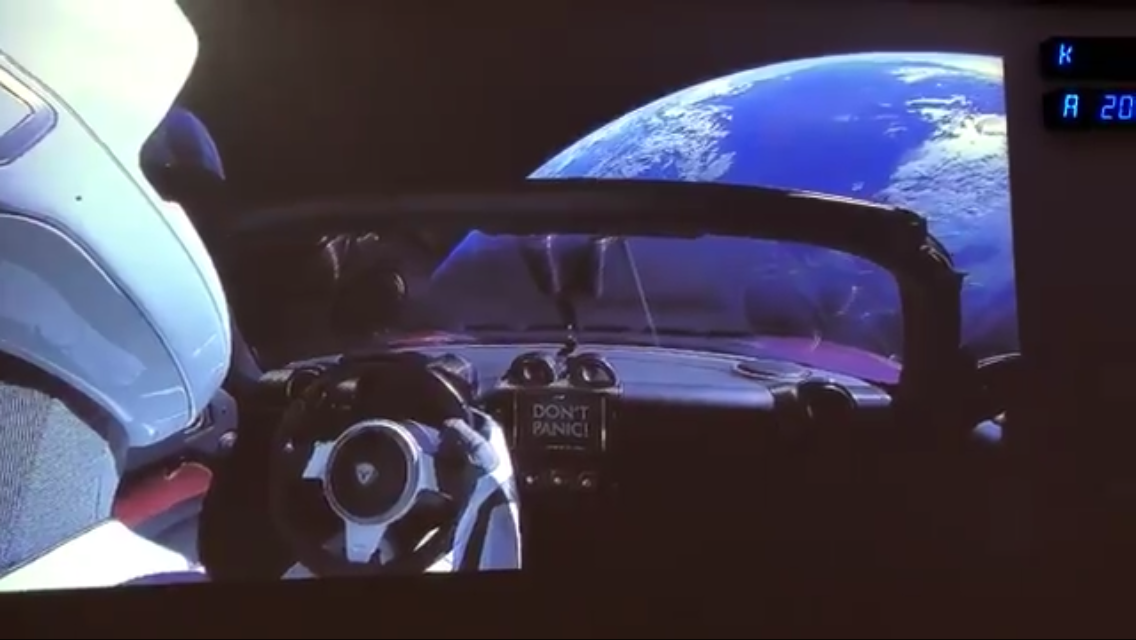
Tuesday, 6 February 2018 ended with the question on everyone’s lips: Did I really just see that? From the largest and most powerful rocket in active service, anywhere in the world, to synchronized landings of two boosters, to a car journeying around the Home Planet, playing the songs of David Bowie, today has been a remarkable day. “Today’s show @NASAKennedy reminded me of a similar image from the not-too-distant past,” tweeted NASA astronaut Ricky Arnold. “Humans doing bold things. What a day!”
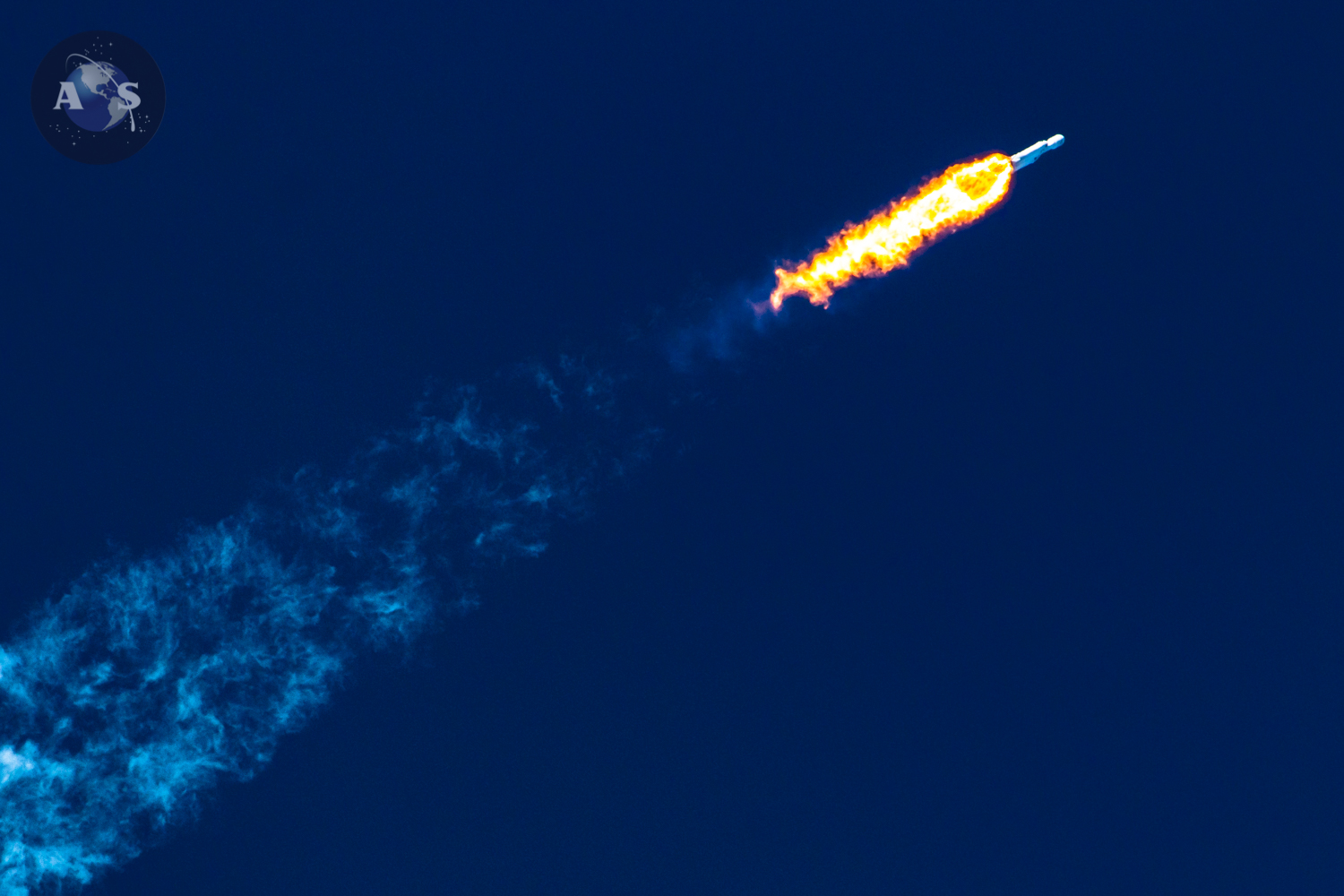
.
FOLLOW AmericaSpace on Facebook!
.





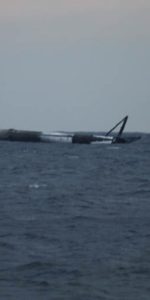
Yes, you did just see that happen. And it was a glorious sight.
TMI completed.
s/c orbital elements: 0.98 x 2.61 AU solar orbit with C3 (Earth) = 12.0 km^2/s^2
Se Jones,
what does this launch mean? Does this qualify the FH as a proven vehicle? Could there still be design issues? Does the lose of the center core impact anything?
“TMI completed.
s/c orbital elements: 0.98 x 2.61 AU solar orbit with C3 (Earth) = 12.0 km^2/s^2”
Is this a proven trajectory to the asteroid belt? Has this trajectory been confirmed by other agencies?
Tracy, why are you asking those questions here, shouldn’t you be asking SpaceX directly?
Scott,
There are a lot of smart people here…
There’s no “ask SpaceX” on their web site.
what does this launch mean?
It means planetary scientists are giddy, ULA managers are -not.
Does this qualify the FH as a proven vehicle?
Not yet, the DoD will require more successful launches before they buy FH for their big expensive birds.
Could there still be design issues? Only very minor ones.
Does the lose of the center core impact anything? Nothing major. They gotta patch up the barge. Make sure the center core carries more “starting fluid” from now on.
Is this a proven trajectory to the asteroid belt? Yeah, pretty much since Newton published that Principia Mathematica book in 1687.
Has this trajectory been confirmed by other agencies? People on night side of the Earth could see the third burn that put the stack on its hyperbolic escape trajectory, there are pictures on the interwebs. I’m sure people will also confirm the flight from the length of the burn, the mass of the stack , and the total impulse of the engine. The last image of “Starman” with the crescent earth in the background also confirms the speed and direction of the stack, not to mention the track of the telemetry signals. I don’t know if the stack was tracked by DoD radar after the third burn, it probably was, but that sort of data would be classified I suppose.
se jones,
I am completely confused and need your input…
Musk now says that:
1. The FH will not be man rated.
2. It will just be a cargo transport.
3. The moon flyby with the paying customers has been nixed apparently.
4. All of SpaceX will now focus on BFR.
5. The BFR is a completely new architecture from the ground up.
6. The Ship portion will be SSTO capable to LEO.
7. The initial testing includes launch then accelerated landings to model “Super-Orbital Velocities” which he further said is “dealing with energies to the 8th power?”.
8. He will need this data to design a new heat shield system that withstand multiple uses.
9. BFR Ship will begin “hopping tests” next year.
10. Complete system test of the BFR Ship & Booster will be in 3 to 4 years.
If it took 7 years to design and build the FH from the F9 which was a variant of existing architecture …Which he said he wanted to quit 3 times, how can he expect a complete new architecture in 4 years…I am thinking 15 years and lets say he is 3 years into BFR. So 12 years from now we might see a BFRSB system test.
This feels like the goal posts keep getting moved back or they really do not want people getting off this planet.
Moon flyby will be on a BFR vehicle.
The BFS with negligble cargo is capable of SSTO, it’s just a statistic, not an operating mode.
The Dragon capsule has already been driven to simulated Mars return EDL speeds, not sure what Masuk meant by that or if you heard it wrong. PICA-X material is already known good for the heat shield.
It took 7 years for the FH because the F9 it was based on was continually being upgraded, including as a test bed for re-usability concepts to bear full fruit in the BFR. (All lot of BFR work is built into the Block 5 F9). The Raptor engine for the BFR has been in development 3 years already, and full flow barely sub-scale examples tested for full duration firing already.
Because of the amount of work they have already done, the BFR will only take 2~4 more years.
” This feels like the goal posts keep getting moved back or they really do not want people getting off this planet. ”
The exact opposite is very much true. They need to finish Crew Dragon and do maintenance engineering only on F9 and it’s variants, and get fairing recovery down. Everything else after those is BFR 24/7/365.
And then the cost drops to get a pound into LEO that the ball really gets rolling.
Tom,
Thanks for the optimism…
Here is the link for the Musk Interview
https://www.youtube.com/watch?v=sytrrdOPYzA
He clearly states that the Dragon Crew will be utilized for F9 launches to LEO only and any extra orbit human transport will come from BFR Ship. I find it difficult to believe that the F9 is really any scale up to the BFR. At the booster level yes I agree but the Ship vs Crew 2 is night and day isn’t it? Lifting body vs Cone…Propulsive Landing vs parachutes. I think the BFR will be the future…Just not in 4 years maybe 10 or 12..Won’t the BFRS be a composite carbon fiber? Which has not been used in something this size? The SLS is struggling with welds holding I have read.
He has the architecture to get out of LEO but he does not want to Human rate it? I think he should plan on both…Just in case BFR breakthroughs don’t come as expected..And it does take 10 years to complete..
” He clearly states that the Dragon Crew will be utilized for F9 launches to LEO only ”
I said nothing different. Composite airframes have been made before, even airliners. The F9 can go past LEO easily enough with multiple launches and assembly by docking.
I have no fear that if the FH get many launches under it’s belt and the BFR seems substantially delayed, SpaceX will launch people on it.
Tom,
Yes I hope that is the case. I really wanted a moon flyby this year with 2 paying tourists.
How does the BFR Ship create a life safety evacuation for the human crew and cargo in the event of RUD (explosion)? This is the classic issue with the Shuttle. Didn’t they initially feel that the Shuttle was RUD proof too? As I recall the crew or some of them survived the explosion only die on impact of the water? The BFR is a combined crew and engine system, hopefully the details will show a separate container program that can decouple if needed. I cannot imagine that design capability will be cheap or easy..
I believe the BFS (2nd stage) is serviceable as a LAS for the BFB (1st stage).
I honestly believe that if all they want is a flyby and are willing to go with a waiver–and SpaceX could get the waiver–a flyby could happen this year. The minimal life support to get by with if you are roughing it is pretty canned. S–t in a baggie, and stow it.
Not that I think it would happen, but it’s physically plausible.
Ben,
Again of course your article is impeccable with detail and accuracy.
“Admittedly, the Heavy does not reach the liftoff thrust achieved by the last few Saturn V vehicles, which peaked at close to 7.6 million pounds (3.4 million kg) and falls far short of the reported 10.2 million pounds (4.6 million kg) attained at launch by the Soviet Union’s ill-fated N-1 super-heavylifter.”
My question was …Wasn’t the Apollo Architecture originally designed by VonBraun to go to Mars?
Apollo Architecture originally designed by VonBraun to go to Mars?”
Well “architecture” implies the whole ball of wax, the Saturn launch vehicle and Apollo spacecraft.
So no, the Apollo/Saturn was designed to get (barely) a couple of guys to the moon, Mars is 100 times harder and the Apollo spacecraft were not applicable to Mars.
But…there’s a lot of silly GC nonsense on the internet about the Saturn V being “a Moon rocket”. No, a launch vehicle is just a machine to put a certain amount mass into orbit. Period.
The VonBraun “Mars 1968” study used the Saturn V to launch the Mars fleet with its nuclear thermal upper stage boosters. The Moon race was a means to an end for VonBraun, Mars was his primary life long goal.
I believe the Saturn C-8 (Nova) with 8, F-1 first stage engines generating 12 million pounds of thrust was designed for missions to Mars as well as a “direct” flight to the moon. Am I correct?
COMPLETELY CORRECT Tom. Falcon H, Delta IV HLV and the SLS will provide the United States the ONLY stop gap Heavy Lift Capability in the world.
You bet.
Further more, the Musk haters just love to type “mini BFR” over and over again to “tap” into their contempt for all things SpaceX. So therefor, if BFR-V2 is “mini BFR”, I guess Saturn V is “mini Nova”.
Apollo mini-Nova. Yeah that’s the ticket.
It was actually the Saturn C-5 with eight F-1 engines each rated at 1.5 million pounds thrust for total of 12 million pounds thrust for a direct ascent trajectory to the Moon.
THIS WAS MAGNIFICENT!!!!!!!!!!!!!!!!!!!!!!!!!!!!!!!!!!!!!!!!!!!!!!!!!!!!!!!!!!!!!!!!!!!!!!!!!
It was like reliving the Glory days of the Moon Race when Apollo 4, SA-501, was launched on 9 November 1967.
The roaring crowd of SpaceX employees also gave it the feeling of the scene in the Classic SciFi Adventure, “Marooned,” when the Titan III/X-RV was launched on its rescue mission.
“Starman” in the Tesla roadster was quite comical to me, at least, but since it did give rather dramatic views of the Earth from orbit, why be negative? It certainly help Tesla Motors on Wall Street today 🙂
It was a GREAT TEST LAUNCH and here’s Hoping that the remainder of the Flight Test Program and eventual routine launches into orbit will Certify the Falcon H as ready to send Americans back to the Moon and on to Mars.
And here’s Hoping that Falcon, Delta and SLS can be used to orbit another Space Station….this one All American.
BTW, I forgot to say that this was INFINITELY BETTER than the computer generated simulations and I was moved near tears when I saw the Stars and Stripes of “Old Glory” on the payload shroud.